|
Tags: art | dynasty | National Palace Museum
The National Palace Museum was founded on October 10th 1925. Imperial collections accumulated throughout the Sung, Yüan, Ming and Ch'ing dynasties were displayed for the enjoyment of the masses for the very first time.
Since 1931, internal disorders and foreign intrusions prompted the republican government to move the most important treasures out of the Forbidden City. The cultural relics traveled over 10,000 miles before they finally arrived in Taiwan almost 40 years later. This toilsome journey became a legend and separated the National Palace Museum from all other museums in the world. Today, the National Palace Museum continues to strive for improvements. It refuses to freeze in 8000 years of Chinese history but would like to carry the civilization into the future.
1. The Neolithic Age ca. 6200-1600 B.C.E.
At the dawn of civilization, jade and earthenware were used to carry out religious rituals and daily tasks. People polished rocks and knew how to heat clay in high temperature kilns to produce earthenware.
Chinese prehistoric jade items are unique in their distinctive regional characteristics. For example, jade artifacts excavated from eastern China are ornamented with animal motifs. Those discovered in western China are noteworthy for their simple and rustic elegance.
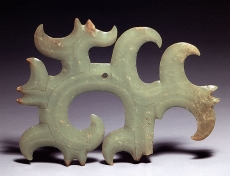
Hooked cloud-shaped pendant
Late Hungshan Culture (ca. 4500-3000 B.C.E)
National Palace Museum
2. Shang and Chou Dynasties ca. 1600-221 B.C.E.
The Shang and Chou dynasties saw the height of the magnificent Bronze Age when costly bronze vessels were made exclusively for nobility. Bronze was cast into both weaponry and ritual implements for sacrificial offerings to ancestors. Patterns on bronze vessels were believed to convey awe and reverence to the gods and ancestors.
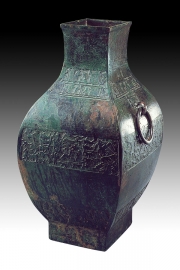
Fang vessel with hunting scene design
Early Warring States period (ca. 5th-3th century B.C.E)
National Palace Museum
3. Ch'in and Han Dynasties 221 B.C.E.-220 C.E.
The first emperor of the Ch'in state replaced the feudal system of the Shang and Chou dynasties with imperial rule in 221 B.C.E. The regal administration was further legitimized when the Han dynasty replaced the Ch'in dynasty to create an empire unified by both politics and culture.
During this time, misty mountains, auspicious animals, dragons and phoenixes filled the surfaces of daily utensils. Not only did they reflect the deep spiritual nature of society, but also the desire for immortality.

Jade pi-hsieh animal to ward off evil
Han Dynasty (206 B.C.E-220 C.E)
National Palace Museum
4. Six Dynasties, Sui and T'ang Dynasties 220-960 C.E.
China underwent multiple phases of fragmentation with intermittent periods of unity from the third to tenth centuries. Social upheaval left the populous in a state of distress and apprehensive about the future. Besides,tribes from neighboring steppe lands gradually migrated into the Central Plains where they introduced new cultural practices. These waves of influence sparked indigenous Chinese art production in terms of technical expertise and innovative artistic forms.

A Palace Concert
Anonymous, T'ang Dynasty (618-907)
National Palace Museum
5. Sung Dynasty 960-1279 C.E.
Marked by cultural expansion, the Sung dynasty is characterized by its austerity and simplicity. Artists upheld the prevailing sense of naturalism and function when creating decorative items and writing utensils. At the same time, the idealistic philosophy Confucianism, which stressed on a keen observation of nature, also encouraged artisans to reveal a celebration of the essence of life.
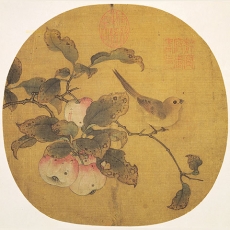
Bird on an Apple Branch
Anonymous, Sung Dynasty (960-1350)
National Palace Museum
6. Yüan Dynasty 1271-1368 C.E.
The Yüan dynasty was founded by the Mongols whose legendary empire stretched across Eurasia. This dynasty witnessed a clearly defined social hierarchy under the Mongol's highly centralized imperial power. Mongol rulers retained traditional costumes, documents, decorative patterns and designs. Thus, evidence of their own nomadic origins was preserved when they built their great empire.

Portrait of Khubilai Khan's Consort (Chabi)
Anonymous, Yüan Dynasty (13th century)
National Palace Museum
7. Ming Dynasty 1368-1644 C.E.
Ming dynasty art was more cheerful and versatile relative to the simple and elegant style of the Sung and Yüan dynasties. In painting, the Ming dynasty witnessed the emergence of the Che School born out of court painting characterized by an unrestrained decorative undertone.
In juxtaposition, the Wu School practiced an elegant style reflective of the literati.
Also,social prosperity coupled with the popularity of collecting antiquities resulted in a period of expanding freedom on many fronts.
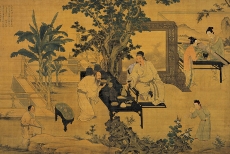
Enjoying Antiquities
Tu Chin (fl. ca. 1465-1505), Ming Dynasty
National Palace Museum
8.Ch'ing Dynasty 1644-1911 C.E.
The Ch'ing dynasty, which was the last Chinese imperial dynasty, had reached the highest stage of its political stability, economic strength and stable social structure. As art and culture was allowed to flourish, magnificent craftsmanship testified to the era's prosperity.
Simultaneously, Western technology was rapidly progressing. Western missionaries provided an additional impetus to the interaction amongst eastern and western cultures, intensifying new energies in Chinese art.
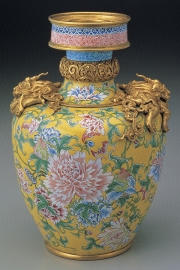
Metal vase with peony flowers and coiled dragons in painted enamels Mark and reign period of Yüng-cheng
Ch'ing Dynasty (1723-1735)
National Palace Museum
|



















